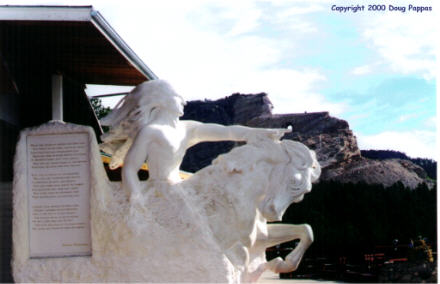Greetings from Sioux City, Iowa, to which I returned about 30 hours after detouring through South Dakota. Tomorrow I resume the drive west on US 20.

But today began with a visit to the Crazy Horse carving near Custer, South Dakota. For more than 50 years, the family of sculptor Korczak Ziolkowski has supervised a project that dwarfs Mt. Rushmore, Stone Mountain and all similar sculptures. They are, very slowly, carving an entire mountain into a three-dimensional likeness of Crazy Horse, his arm extended, riding a stallion. When complete, the work will stand 563' high, with the outstretched arm alone stretching 263 feet. (Check it out at www.crazyhorse.org.) Crazy Horse's face is now complete. The rest, visible in rough outline, may take another half-century or more -- especially as the project refuses all offers of government funding.
And while in the area, I checked out the new visitor facilities at Mt. Rushmore, 17 miles up the road from Crazy Horse. One huge issue arose at once. Admission to Rushmore has always been free -- but now the main parking lot is controlled by a private vendor which charges $8 to park in front of the visitor center! That's as much as I paid for admission to Crazy Horse, where my money's used to blow up the mountain. Free parking is available in auxiliary lots down a steep hill, but for the elderly, the handicapped and parents with strollers, those aren't especially good options. Moreover, the visitor center is now underneath the main viewing terrace, invisible to visitors as they enter from any of the parking lots. Instead, the two large buildings facing the mountain house the cafeteria and the gift shop. I expect this from Disney, not from the National Park Service.
(Trivia: Mt. Rushmore got its name from a joke. In 1885 a young New York lawyer named George Rushmore was vacationing in what was then Dakota Territory. Pointing to the then-unnamed peak, he asked his guide what it was called. "I call it Mount Rushmore," joked the guide...and the name stuck. Forty years later, when sculptor Gutzon Borglum selected the mountain for his carvings, the astonished George Rushmore contributed $5,000 toward the project.)
From Rushmore, I returned to Rapid City and headed toward the Badlands, passing dozens of tourist businesses en route. The Black Hills would be a wonderful place for a family vacation, if I ever find myself taking one. A special favorite is Reptile Gardens, a Florida-style attraction featuring poisonous snakes, gator wrestling and a bird show a la Parrot Jungle. There's also a drive-through wildlife park, a half-dozen commercial and NPS-run caves, an old steam train, waterslides, miniature golf, "chuck wagon" Western suppers, and miles of hiking trails...not to mention casinos in Deadwood and the annual biker convention in Sturgis. Further east, though, there are the Badlands, multicolored formations carved by erosion over millions of years. Instead of the usual loop road through the park, I opted for a 30-mile dirt road through another side...but just as I reached the park, heavy cloud cover obscured the subtle hues in the formations I had come to see.
No such problems awaited me at my next destination: legendary roadside emporium Wall Drug. Wall, SD has a year-round population of about 830; in midsummer, up to 20 times that many visitors stop in a single day. They follow the trail of homespun billboards to the Interstate exit guarded by an 80-foot dinosaur, then continue a half-mile or so to a two-block complex with a 530-seat cafe, thousands of historical photos, dozens of bizarre photo opportunities and every type of wholesome souvenir known to man. (Not to mention an actual working pharmacy -- the only one in a 2,000-square-mile area.) Wall Drug has advertised in such unlikely places as the London subways and Paris Metro; South Dakotans have spread its fame stil further, carrying Wall Drug signs to the South Pole, the Taj Mahal, and on military maneuvers around the globe. When founder Ted Hustead died in January 1999, age 96, the New York Times gave him a three-column obituary.
Retracing my steps, I was conscious of going against the flow. For maximum effect, I-90 across South Dakota route should be driven east to west. The billboards begin just west of Sioux Falls, even though many of the attractions are more than 200 miles away. There's no intrinsically interesting route across the Great Plains, but through their signs, the good folks at Wall Drug, the Corn Palace, the Pioneer Auto Museum, the Rushmore-Borglum Story, Reptile Gardens, Badlands Petrified Gardens, and the 1880 Town have created the next best thing: a sense of anticipation as the miles click away, until a final barrage of billboards beckons the traveler to stop. If you've ever seen the South of the Border billboards along I-95, it's the same idea, though in South Dakota both the billboards and the attractions are much lower key.
If I had to choose one place to spend two or three days on vacation, it would be Yellowstone National Park...where, conveniently, I'll be spending most of Wednesday and Thursday. But for a 2-3 day roadside vacation, give me South Dakota.
Now, though, I'm back in Iowa. ("Is this heaven? HELL NO, it's Iowa!"). Sioux City has one bona fide historic site: the spot along the Missouri River bluffs where Sgt. Floyd, the only fatality of the Lewis & Clark expedition, was buried in 1804. It also houses a radio station which cluelessly operates under the call letters KSUX. They pronounce it "K-Sue" and identify the station, for some reason, as "The Super Pig," but after 10 minutes of its Godawful "lite country" I will always remember it as "The Station That Really SUX."
Speaking of which, tomorrow is Northern Nebraska Day. I may bring a book to read while driving...
Go to the next day
Back to NEWS FROM THE ROAD menu
Back to ROADSIDEPHOTOS.COM home page